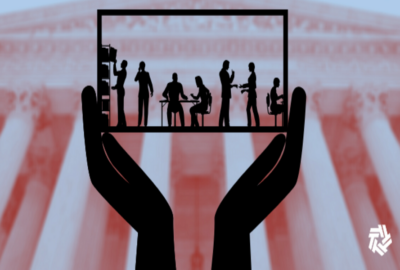The government’s top role for workforce diversity will soon be vacant. What happens next?
During her time as governmentwide chief diversity officer, Janice Underwood led significant strides in the Biden administration’s DEIA goals. But at the same...
As the first-ever governmentwide Chief Diversity Officer Janice Underwood prepares to exit her role, agencies are still trying to turn up the dial on diversity, equity, inclusion and accessibility (DEIA) goals.
Leaving to take a similar diversity leadership role at Disney, Underwood’s departure from the government will leave a gap in managing the DEIA work that agencies have been trying to accomplish for the last several years.
Underwood has held her position, created under President Joe Biden’s 2021 executive order on DEIA, since May 2022. The key DEIA role is housed in the Office of Personnel Management and is responsible for coordinating efforts across agencies to advance the executive order.
“I approached this role with authenticity — I wasn’t trying to be anyone else,” Underwood said in an email to Federal News Network this week.
During her less than two years holding the position, Underwood saw significant strides in the Biden administration’s DEIA goals — such as establishing a council to convene DEIA leaders governmentwide, publishing the first-ever DEIA annual report, and outlining guidance on how agencies can create a gender-inclusive workplace.
“Thanks to her leadership, federal agencies are better equipped and supported as they advance DEIA and build a workforce that better serves the American people,” OPM Director Kiran Ahuja said in a statement. “This work is essential in our ability to recruit, hire and retain the best talent across the country.”
Over the last couple years, federal employees’ perceptions of DEIA work in government also improved. The DEIA index in the Federal Employee Viewpoint Survey (FEVS) rose two points between 2022 and 2023, from 69% to 71%. Underwood, during a Chief Human Capital Officers (CHCO) council meeting last month, called the increase in FEVS “herculean.”
“These governmentwide results will serve as a baseline to assess future changes, as well as benchmark comparisons for agency DEIA initiatives,” she said.
Once vacated, OPM is planning to fill the chief diversity officer role. But in the meantime, agencies haven’t had the easiest time reaching DEIA goals. There has been “mixed success” in increasing workforce diversity, the Government Accountability Office has found.
For instance, in a Jan. 24 report, GAO said although the Intelligence Community’s workforce was able to increase the representation of women and racial or ethnic minorities, the IC still wasn’t meeting broader federal benchmarks.
And while the federal workforce is becoming more diverse overall, the diversity of employees in the upper levels of the General Schedule, as well as in the Senior Executive Service, are lagging behind on diversity. Additionally, although many agencies have been able to increase representation of employees with disabilities over the past several years, GAO found many leave their federal jobs within two years of being hired.
Many agency human capital leaders, as OPM summarized in a recent human capital report, have said they need clarification in the roles and goals of DEIA as well. A lack of dedicated funding, vacant chief diversity officer (CDO) positions, understaffed DEIA offices, and dispersion of DEIA work, goals, and role all put the administration’s goals to advance DEIA in the federal workforce at risk. Widespread geographic dispersion of workforces as well as “insularity” of agency cultures also contribute to the challenges, OPM said.
“It is never easy to operate in a state of uncertainty, so vacancies certainly make our work more challenging,” Underwood said. “But what we’ve accomplished in the last year has been only because of the governmentwide approach and the DEIA leaders across all our agencies.”
And while several agencies still have vacancies for their chief diversity officer positions, Underwood said she sees the Chief Diversity Officers executive council as a “force-multiplier” and an opportunity for agencies to collaborate and find best practices.
OPM has also pointed to some agencies who are leading the charge in terms of DEIA advancements. The U.S. Agency for International Development (USAID), for instance, conducted a DEIA survey encompassing over 60% of the agency’s workforce across 30 demographic categories, including first-generation professionals and different generations.
In another example, the Energy Department implemented a “structured approach” to recruitment by adding new DEIA-related requirements for hiring managers and others working in the agency’s HR department. For the 2023 FEVS, Energy received a score of 80% on the DEIA index — nine points above the governmentwide average.
To move forward even further, agencies must better analyze their demographic data to assess progress and find root causes for any issues, OPM said. During 2023, OPM created a DEIA dashboard to try to help agencies better understand some of that data.
“But access to and the capacity to use that data is currently a challenge,” OPM said in its human capital report.
Going forward, agencies are calling on OPM for more guidance on analyzing their applicant data and how to conduct studies on pay equity in the federal workforce among various demographic groups. Agencies have also asked OPM for help with education and awareness of what DEIA means, and more clarity on roles and objectives. And agencies requested a DEIA job series with clearly defined competencies, so they can understand how to recruit for those positions.
For more support, Underwood recommended agencies go back to the basics — look again at the 2021 executive order that began the DEIA drive in government. Importantly, the order defines “diversity,” “equity,” “inclusion” and “accessibility,” and outlines how agencies should develop their DEIA strategic plans.
“The executive order outlines how promoting DEIA supports the nation’s largest employer, the federal government, to be a model for DEIA, where all employees are treated with dignity and respect, and strengthen the federal government’s ability to recruit, hire, develop, promote and retain our nation’s talent and remove barriers to equal opportunity,” Underwood said.
OPM’s guidance on promising practices for DEIA, published in December 2023, should help agencies figuring out how to embed DEIA in everything from targeted recruitment and outreach, to performance management of current employees, Underwood added.
“It’s important to note that sustaining initiatives in each part of the D, the E, the I and the A requires commitment and prioritization across functions,” Underwood said. “This will allow DEIA to be fully integrated into and across agency culture, budget, learning agenda, human capital operating plans and overall strategic plans.”
And Underwood’s advice for her successor? Bring expertise, passion and drive to the position.
“Build relationships with OPM staff, members of the DEIA initiative and senior leaders and chief diversity officers across the federal government,” Underwood told Federal News Network. “Listen more than anything else and remember that our priority is and always must be serving everyone in the federal workforce.”
Copyright © 2025 Federal News Network. All rights reserved. This website is not intended for users located within the European Economic Area.
Drew Friedman is a workforce, pay and benefits reporter for Federal News Network.
Follow @dfriedmanWFED






